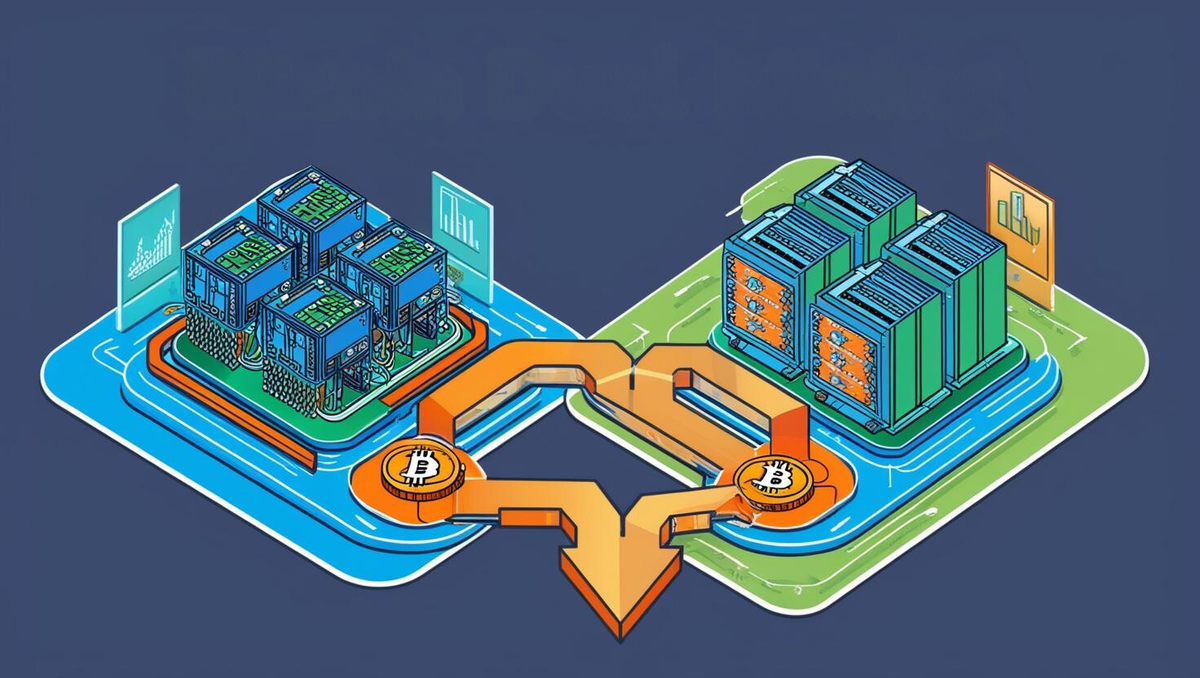Understanding the Working Principle of Bitcoin Dual Mining: Advantages and Disadvantages

Bitcoin mining has evolved significantly over the years, with miners continuously seeking ways to maximize their profitability and efficiency. One of the innovative approaches that has emerged is dual mining, where a miner can mine two different cryptocurrencies simultaneously, often combining Bitcoin (BTC) with another altcoin. This method allows miners to diversify their rewards and improve the overall profitability of their mining operations. However, it also comes with its own set of challenges and trade-offs.
In this article, we will explore the working principles of Bitcoin dual mining, its potential profitability, and the advantages and disadvantages of this approach.
What Is Bitcoin Dual Mining?
Dual mining refers to the process where a mining rig (typically a GPU or ASIC) is used to mine two different cryptocurrencies at the same time. The idea is to utilize the full potential of the hardware by allocating part of its computational power to mine Bitcoin and the remaining to mine another cryptocurrency. This allows miners to earn rewards from both blockchains without needing to invest in separate hardware for each coin.
Dual mining is often associated with GPU mining, as GPUs are versatile and can handle different algorithms. Bitcoin, however, is mined using ASICs (Application-Specific Integrated Circuits), which are specifically designed for the SHA-256 algorithm used by Bitcoin. In some cases, miners can mine Bitcoin with ASICs and simultaneously mine another cryptocurrency using a GPU, which is attached to the same rig or setup.
How Does Bitcoin Dual Mining Work?
The key to dual mining is the ability to mine two different cryptocurrencies that use distinct algorithms without overloading the hardware. Here’s how it works:
- Mining Algorithms: Bitcoin uses the SHA-256 algorithm, which requires significant computational power and is handled by ASIC miners. Other cryptocurrencies use different algorithms that may be more GPU-friendly, such as Ethash (used by Ethereum before the merge) or Scrypt (used by Litecoin). Dual mining leverages this difference in algorithms to mine two coins at once.
- Resource Allocation: The mining software allocates a portion of the hardware's resources to each cryptocurrency. Typically, most of the ASIC's power is dedicated to mining Bitcoin, while a smaller portion of the system’s GPU can be directed toward mining the second cryptocurrency, which uses a different algorithm. This maximizes the use of available hardware without significantly affecting the efficiency of Bitcoin mining.
- Profitability Calculation: Since dual mining requires balancing the resource allocation between two algorithms, miners must calculate whether the second cryptocurrency can provide enough additional profit to justify the energy and hardware use. Dual mining software, like NiceHash or PhoenixMiner, helps miners manage this balance by monitoring power consumption, hash rates, and profitability in real-time.
- Mining Pools: Most miners participate in mining pools, especially when dual mining. These pools allow multiple miners to combine their computational power, increasing their chances of solving blocks and earning rewards. In dual mining, miners can join separate pools for each cryptocurrency, or use pools that support dual mining directly.
Advantages of Bitcoin Dual Mining
- Increased Profitability
The main reason miners opt for dual mining is the potential to increase overall profitability. By mining a second cryptocurrency alongside Bitcoin, miners can earn additional rewards without investing in extra hardware. This provides an additional income stream, which can make mining more lucrative, especially in markets where cryptocurrency prices are volatile. - Maximizing Hardware Efficiency
Dual mining allows miners to maximize the efficiency of their hardware. Instead of letting a portion of the system's resources remain idle while mining one cryptocurrency, miners can fully utilize both GPUs and ASICs by mining two coins simultaneously. This is especially important in periods of low Bitcoin prices when Bitcoin mining alone may not be as profitable. - Diversification of Mining Rewards
By earning two different types of coins, miners can diversify their mining portfolio. This helps reduce risk in the event that the price of one cryptocurrency falls significantly. For example, if Bitcoin’s price decreases, the second coin might remain stable or even increase in value, helping offset potential losses. - Lower Barrier for Altcoin Mining
Dual mining provides a way for miners to participate in altcoin mining without having to buy additional hardware. Many altcoins require different hardware or algorithms that can be costly to mine independently. By dual mining, miners can enter the altcoin space with their existing hardware setup.
Disadvantages of Bitcoin Dual Mining
- Increased Energy Consumption
While dual mining allows miners to earn from two cryptocurrencies, it also increases energy consumption. Mining two coins at once requires additional power, and this can cut into the profitability of dual mining, especially if electricity costs are high. The increased power demand can lead to higher operating costs, reducing the net profit. - Lower Performance for Each Cryptocurrency
Dual mining divides the hardware's resources between two algorithms. This means that while miners are earning rewards from both coins, the performance of each may not be as high as it would be if the system was dedicated to mining one coin. For example, miners might see a drop in their Bitcoin mining performance as part of the resources is redirected to the secondary cryptocurrency. - Complex Setup and Maintenance
Setting up dual mining requires configuring both the hardware and software to work with two different mining algorithms. This can be complex, especially for less-experienced miners. Additionally, managing two mining operations simultaneously increases the need for monitoring and maintenance. Miners may face more frequent technical issues, and troubleshooting can be more challenging compared to single-coin mining. - Profitability Dependent on Market Conditions
The profitability of dual mining is highly dependent on the market value of the second cryptocurrency. If the price of the second coin drops, or if its difficulty increases significantly, the rewards from dual mining may not justify the additional energy costs and hardware wear. Miners must regularly evaluate the market conditions to ensure that dual mining remains profitable.
Is Bitcoin Dual Mining Worth It?
Whether or not Bitcoin dual mining is worth it depends on several factors, including electricity costs, hardware efficiency, and the market value of the second cryptocurrency. In some cases, dual mining can significantly boost profitability, particularly during periods when the prices of altcoins are rising.
However, dual mining may not always be the best choice for every miner. The increased energy consumption, hardware complexity, and fluctuating profitability of altcoins can make dual mining less attractive, especially for smaller miners or those with limited technical expertise.
Conclusion: Balancing Profitability and Complexity
Bitcoin dual mining offers a unique way for miners to maximize their hardware's potential and increase their profitability by earning rewards from two cryptocurrencies simultaneously. By mining Bitcoin alongside an altcoin, miners can take advantage of different algorithms to diversify their income streams.
However, dual mining also presents several challenges, including higher energy costs, reduced performance for each coin, and increased maintenance complexity. Miners must carefully evaluate whether the additional rewards from dual mining are enough to offset these challenges, especially in light of market conditions and hardware limitations.
In the end, dual mining can be a profitable strategy for those with access to low-cost electricity and the technical expertise to manage a more complex mining setup. For others, sticking with single-coin mining or using a mining pool may be the more straightforward and stable option.
This article presented by Loka Mining.
Loka is revolutionizing the Bitcoin mining ecosystem by directly connecting investors with Bitcoin miners through a decentralized mining pool and an upcoming permissionless forward hashrate marketplace protocol.
Loka enables investors to get Bitcoin at lower than market price without centralized & counter-party risks, and Bitcoin miners to access capital efficient financing and hedge their risk exposure by selling their future mining rewards.
Find out more about loka in https://lokamining.com — or access our mining pool aggregator on https://pool.lokamining.com





